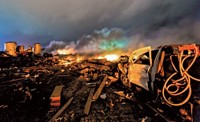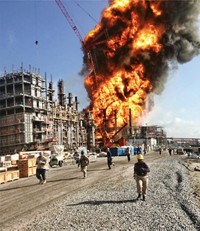Advertisement
Grab your lab coat. Let's get started
Welcome!
Welcome!
Create an account below to get 6 C&EN articles per month, receive newsletters and more - all free.
It seems this is your first time logging in online. Please enter the following information to continue.
As an ACS member you automatically get access to this site. All we need is few more details to create your reading experience.
Not you? Sign in with a different account.
Not you? Sign in with a different account.
ERROR 1
ERROR 1
ERROR 2
ERROR 2
ERROR 2
ERROR 2
ERROR 2
Password and Confirm password must match.
If you have an ACS member number, please enter it here so we can link this account to your membership. (optional)
ERROR 2
ACS values your privacy. By submitting your information, you are gaining access to C&EN and subscribing to our weekly newsletter. We use the information you provide to make your reading experience better, and we will never sell your data to third party members.
Safety
Reactive Chemical Rules Lacking
Chemical Safety: Inquiry faults company, regulators for deadly Texas explosion
by Jeff Johnson
April 23, 2014
| A version of this story appeared in
Volume 92, Issue 17

On the one-year anniversary of the West Fertilizer Co. explosion, the Chemical Safety & Hazard Investigation Board (CSB) returned to the West, Texas, community where the retail fertilizer warehouse had been located. There, at a public meeting on April 22, CSB released its preliminary accident report that proposes changes to federal laws overseeing reactive chemicals.
CSB’s investigation found severe shortcomings in existing regulations and standards for ammonium nitrate at the federal, state, and county levels as well as a “failure by the company to take necessary steps to avoid a preventable accident,” CSB Chairperson Rafael Moure-Eraso said.
The West accident occurred when some 40 to 60 tons of ammonium nitrate fertilizer held in a wooden building caught fire and exploded, killing 14 people—12 volunteer firefighters and other emergency responders and two residents. Another 226 citizens of West were injured. Some 150 homes were destroyed by the blast and twice that many were damaged. An apartment complex, three schools, a nursing home, and a hospital were also damaged.
Moure-Eraso noted that Texas lacks a statewide fire code, which could have encouraged county fire departments to closely monitor and would have held companies responsible for safe storage and handling of chemicals. Such codes, CSB said, could have also kept populations away from hazardous facilities, such as the warehouse.
The CSB investigation found that the community was largely unaware of the threat posed by the supply of ammonium nitrate in the warehouse, as well as another 100 tons that was held in a railcar adjacent to the facility. When built in 1961, the warehouse was surrounded by open fields, but CSB said that, over the years, homes, schools, and other buildings had been located nearby.
In its investigation, CSB found throughout the nation some 1,351 facilities, similar to the one in West, that hold ammonium nitrate fertilizer. Most are in 10 southern agricultural states.
CSB proposed several changes to federal laws, including adding reactive chemicals, such as ammonium nitrate, to substances regulated by the Environmental Protection Agency and Occupational Safety & Health Administration. The board also included a familiar recommendation in its preliminary report—the requirement for inherently safer design.
In this case, Moure-Eraso said such an approach would call for constructing the warehouse from concrete, rather than wood; reformulating the ammonium nitrate fertilizer to decrease its potential for detonation; and reducing the amount stored on site.
A full CSB report is expected later this year.





Join the conversation
Contact the reporter
Submit a Letter to the Editor for publication
Engage with us on Twitter